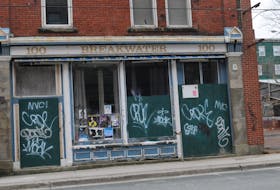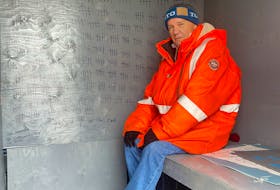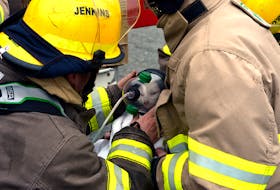CORNER BROOK — There are numerous interesting places that professional geologists and amateur rock lovers would love to explore on the island of Newfoundland.
Some of them are right there on the side of the road, while some require a long trek or a vehicle other than a car to observe.
One geologist, Martha Hickman Hild, has put together a new field guide that highlights 48 sites of great interest that not only tell the island's unique geological tale, but are also accessible in the family car.
"Geology of Newfoundland: Touring through time at 48 scenic sites" has only recently been released and is Hickman Hild's contribution to spreading her own passion for Newfoundland's geological history.
"I was motivated mainly by the fact that the geology of Newfoundland is so remarkable," she said. "It's absolutely unique and people come here from all over the world to see it."
The way the book is written is based on the traditional trans-island field trip started by Harold (Hank) Williams, the province's best-known native geologist and an expert in the tectonic activity that makes Newfoundland geology such an attraction to those who understand it.
Hickman Hild hopes her field guide can help explain the rocky story to anyone who wants to learn about it.
"I wanted to make a book that anyone could use to find some of the best and most beautiful and informative sites," she said.
"I have visited around 150 sites, looking for the ones anyone could get to without needing a boat or some sort of accessory vehicle or having to walk 10 miles to get there."
The guide contains many sites that are advertised by highway signage or brochures, such as Green Point in Gros Morne National Park. Green Point, which is one of two images gracing the book's cover, is significant because it actually represents the division between the Cambrian and Ordovician periods of geological history.
There are many sites that are not advertised, but are quite interesting in their own right.
One such example in western Newfoundland, namely Piccadilly Head on the Port au Port Peninsula, happens to be one of Hickman Hild's favourites.
The folds of rock near Piccadilly Beach are related to the churning tectonic activity that gave rise to the earth's mantle hundreds of millions of year ago.
The mantle, normally found below the earth's surface rises in formations such as the nearby Lewis Hills, the southernmost of four sections of the earth's crust pushed above ground and stretching northward to The Tablelands in Gros Morne National Park.
"You can kind of picture the scale of this whole process and the immensity of what happened with these ocean floor components being pushed up," she said.
Other fascinating points of interest in western Newfoundland include the ancient thrombolite fossils off the Northern Peninsula highway to the more recent, but still ancient, petrified forest found just a short walk from the bridge crossing Blanche Brook in Kippens.
Th field guide divides the four distinct geological zones found across the island from west to east — namely, the Humber, the Dunnage, the Gander and the Avalon — with each zone being colour-coded for easy access by the reader.
Each specific site gets a four-page treatment that includes maps, photos and a load of other information about the site's accessibility.
It also has interpretations of what is observable during the visit or what has been studied in a lab by experts.
There is also an introduction to geological concepts for the beginning geologist and a glossary to help better understand the sometimes unavoidable jargon that comes with earth science.
The 276-page field guide is available in stores across the province and can be ordered online from the publisher at www.boulderpublications.ca .
CORNER BROOK — There are numerous interesting places that professional geologists and amateur rock lovers would love to explore on the island of Newfoundland.
Some of them are right there on the side of the road, while some require a long trek or a vehicle other than a car to observe.
One geologist, Martha Hickman Hild, has put together a new field guide that highlights 48 sites of great interest that not only tell the island's unique geological tale, but are also accessible in the family car.
"Geology of Newfoundland: Touring through time at 48 scenic sites" has only recently been released and is Hickman Hild's contribution to spreading her own passion for Newfoundland's geological history.
"I was motivated mainly by the fact that the geology of Newfoundland is so remarkable," she said. "It's absolutely unique and people come here from all over the world to see it."
The way the book is written is based on the traditional trans-island field trip started by Harold (Hank) Williams, the province's best-known native geologist and an expert in the tectonic activity that makes Newfoundland geology such an attraction to those who understand it.
Hickman Hild hopes her field guide can help explain the rocky story to anyone who wants to learn about it.
"I wanted to make a book that anyone could use to find some of the best and most beautiful and informative sites," she said.
"I have visited around 150 sites, looking for the ones anyone could get to without needing a boat or some sort of accessory vehicle or having to walk 10 miles to get there."
The guide contains many sites that are advertised by highway signage or brochures, such as Green Point in Gros Morne National Park. Green Point, which is one of two images gracing the book's cover, is significant because it actually represents the division between the Cambrian and Ordovician periods of geological history.
There are many sites that are not advertised, but are quite interesting in their own right.
One such example in western Newfoundland, namely Piccadilly Head on the Port au Port Peninsula, happens to be one of Hickman Hild's favourites.
The folds of rock near Piccadilly Beach are related to the churning tectonic activity that gave rise to the earth's mantle hundreds of millions of year ago.
The mantle, normally found below the earth's surface rises in formations such as the nearby Lewis Hills, the southernmost of four sections of the earth's crust pushed above ground and stretching northward to The Tablelands in Gros Morne National Park.
"You can kind of picture the scale of this whole process and the immensity of what happened with these ocean floor components being pushed up," she said.
Other fascinating points of interest in western Newfoundland include the ancient thrombolite fossils off the Northern Peninsula highway to the more recent, but still ancient, petrified forest found just a short walk from the bridge crossing Blanche Brook in Kippens.
Th field guide divides the four distinct geological zones found across the island from west to east — namely, the Humber, the Dunnage, the Gander and the Avalon — with each zone being colour-coded for easy access by the reader.
Each specific site gets a four-page treatment that includes maps, photos and a load of other information about the site's accessibility.
It also has interpretations of what is observable during the visit or what has been studied in a lab by experts.
There is also an introduction to geological concepts for the beginning geologist and a glossary to help better understand the sometimes unavoidable jargon that comes with earth science.
The 276-page field guide is available in stores across the province and can be ordered online from the publisher at www.boulderpublications.ca .








